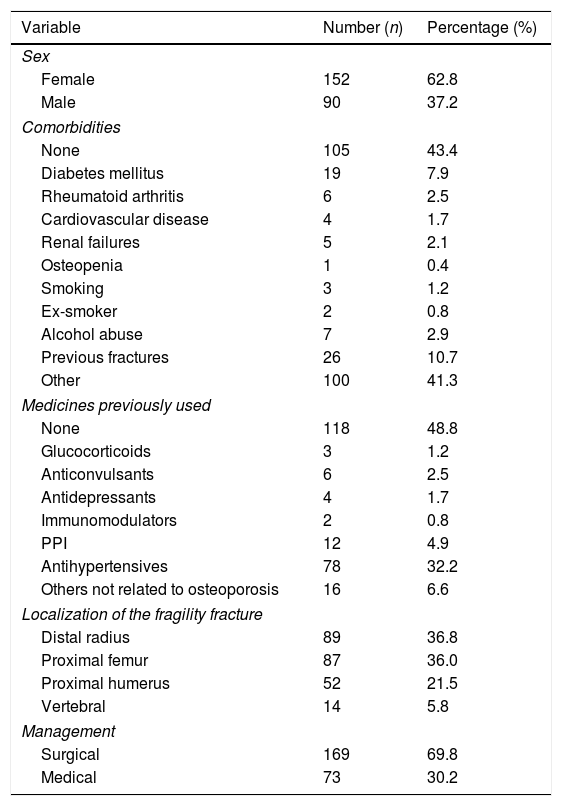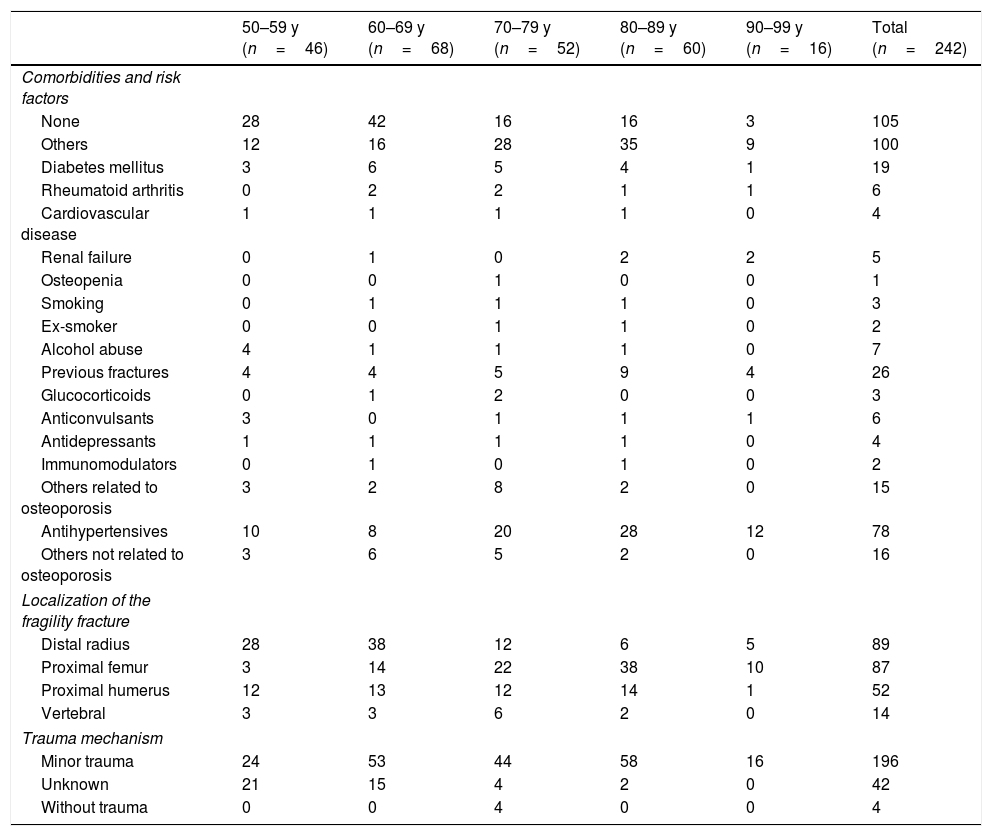Fragility fractures are a frequent complication of osteoporosis and lead to increased morbidity and mortality, as well as decreasing quality of life of the elderly population, and represents high costs for health care systems. After minor trauma, fractures of the femoral neck, distal radius, proximal humerus, and thoraco-lumbar vertebrae are associated with osteoporosis, and are considered fragility fractures.
ObjectiveTo identify the prevalence of risk factors in people over 50 years of age with fragility fractures treated at a third level hospital in the department of Boyacá, Colombia.
MethodologyObservational, descriptive, retrospective cross-sectional study. An evaluation was made on 242 patients between 50 and 100 years of age with any of the previously mentioned 4 fragility fractures. Fracture diagnosis had to be confirmed by plain radiography or computed tomography.
ResultsThe majority (62.8%) of the study population was female. Age was associated with an increase in the number of femur fractures. A history of previous fractures was observed in 10.7% of the cases, with prevalence increasing with age. Distal radius fracture was the most frequent in 36.8% of the population. About 40% of the patients had hypertension and 7.9% were diabetic. Chronic use of Proton Pump Inhibitors (PPIs) was observed in 9.7%, and 2.4% consumed glucocorticoids prior to the event.
ConclusionsThe behaviour of fragility fractures of the population in our institution is similar to that of other places, both nationally and internationally. It is therefore important to start raising awareness about secondary prevention of osteoporosis, in order to reduce complications, improve outcomes, and reduce associated costs.
Las fracturas por fragilidad son una complicación frecuente de la osteoporosis y generan alto impacto en la calidad de vida del adulto mayor. Las fracturas de cuello femoral, radio distal, húmero proximal y vértebras toracolumbares, en el contexto de un traumatismo menor, se consideran fracturas por fragilidad.
ObjetivoIdentificar la prevalencia de factores de riesgo en personas mayores de 50 años con fracturas por fragilidad atendidas en un hospital del departamento de Boyacá.
MetodologíaEstudio observacional, descriptivo y de corte transversal. Se incluyeron 242 pacientes que presentaron fracturas por fragilidad con diagnóstico confirmado por estudio imagenológico.
ResultadosEl 62,8% de la población fue femenina. La edad condiciona un aumento del número de fracturas de fémur. El 10,7% de la población tenía un antecedente de fractura, con un aumento de la prevalencia a mayor edad. La fractura de radio distal fue la más frecuente en el 36,8% de la población. Cerca del 40% de los pacientes era hipertenso y el 7,9% tenía diabetes, en tanto que el 9,7% era consumidor crónico de inhibidores de la bomba de protones. El 2,4% consumía glucocorticoides previamente al evento.
ConclusionesEl comportamiento poblacional de las fracturas por fragilidad en nuestra institución es similar al de otros lugares, tanto a escala nacional como internacional. Por tanto, es importante empezar a crear conciencia sobre la prevención secundaria de la osteoporosis, con el fin de disminuir las complicaciones, mejorar los desenlaces y disminuir los gastos que consigo trae.








